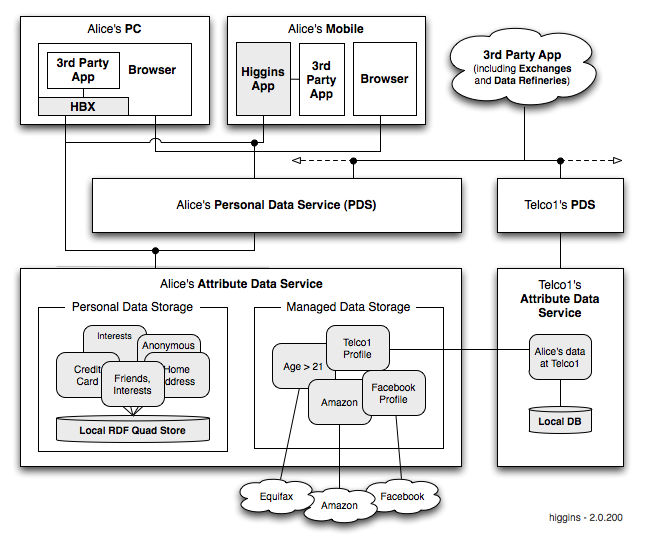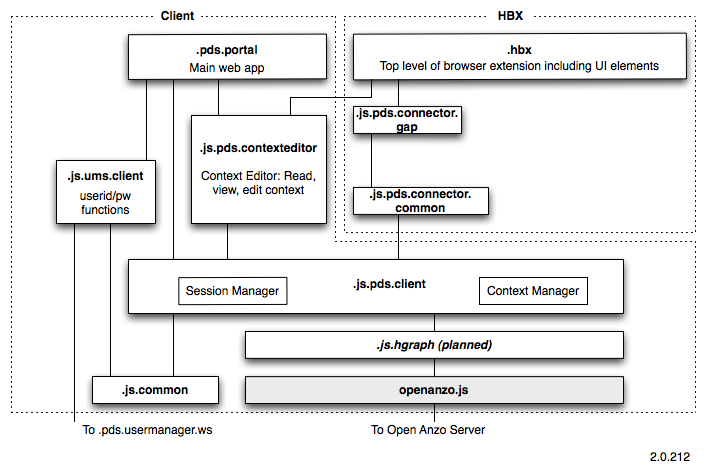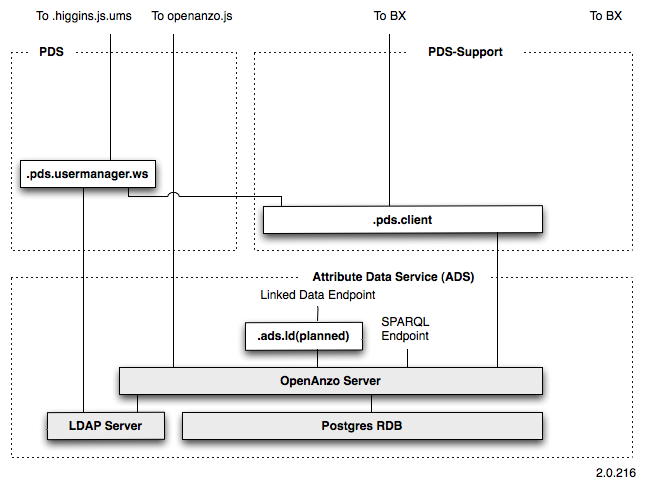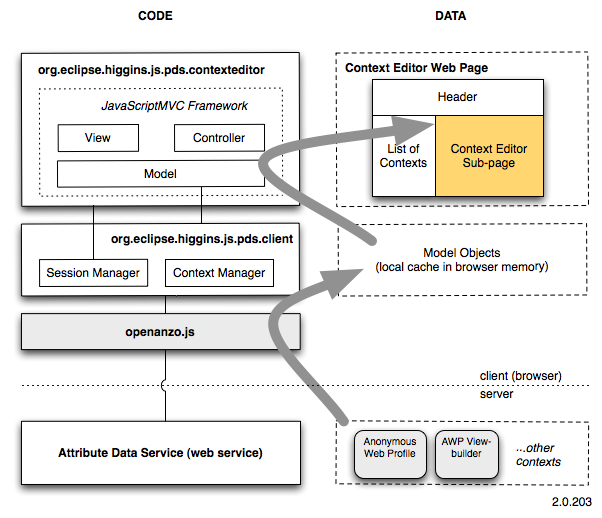Notice: this Wiki will be going read only early in 2024 and edits will no longer be possible. Please see: https://gitlab.eclipse.org/eclipsefdn/helpdesk/-/wikis/Wiki-shutdown-plan for the plan.
Difference between revisions of "PDS Architecture"
(→Components) |
(→Components) |
||
| Line 60: | Line 60: | ||
This section describes the Higgins 2.0 PDS components under active development. | This section describes the Higgins 2.0 PDS components under active development. | ||
| − | + | There are two '''front end''' components: a web app client, and a browser extension. | |
| − | + | [[Image:Client 2.0.212.png|center]] | |
| + | |||
| + | ; Client : The client is written in HTML and JavaScript and runs in any desktop browser (e.g. IE, FF, Safari, Chrome). In the future we also plan to make it display well on the limited screen size of smartphone mobile browser (e.g. iPhone, Android, etc.). | ||
| + | ;HBX: | ||
| + | The Higgins browser extension makes possible functionality that isn't possible in a pure web app architecture. One kind of functionality is browser-side integration with other web APIs and sites. Shown above is a connector that imports the user's advertising preferences from Google's Ad Preference page (http://www.google.com/ads/preferences). | ||
| − | + | There are three '''back end''' components mostly written in Java and running in the cloud (e.g. Amazon AWS): | |
| + | * PDS | ||
| + | * PDS Support | ||
| + | * ADS | ||
| + | And lastly the data model: | ||
| + | * Persona Data Model | ||
| − | + | [[Image:Server 2.0.216.png|center]] | |
| − | + | PDS Subcomponents: | |
| − | + | *.pds.usermanager.ws - simple web service to manage user accounts, change password, etc. | |
| − | + | PDS Support Subcomponents: | |
| − | + | *.pds.client - wrapper around Open Anzo java client | |
| − | + | ADS Subcomponents: | |
| − | + | ||
| − | + | ||
| − | + | ||
| − | + | ||
| − | + | ||
| − | + | ||
| − | + | ||
*PLANNED: .ads.ld - Linked Data endpoint | *PLANNED: .ads.ld - Linked Data endpoint | ||
Revision as of 17:59, 23 August 2011
{{#eclipseproject:technology.higgins|eclipse_custom_style.css}}A PDS is a cloud-based service that works on behalf of you, the individual. It gives you a central point of control for personal information about a you. Things like your interests, contact information, addresses, profiles, affiliations, friends, and so on. A PDS is a place where you establish bi-directional data flows between external businesses and your PDS. Or between your friends' PDS and your PDS.
Contents
Long Term Goals
This section is aspirational. It describes the vision we have for Higgins 2.0. Other sections describe actual code and progress we're making towards this vision.
Data Management. In some cases the data itself flows directly between the data provider and the data consumer, while in others the data flows through the PDS intermediary. In some cases the source of the data is the PDS's local storage. In cases where data flows from or through the PDS, we have the opportunity to map it into a normalized data model, provide the ability to see the data values, and in some cases be able to edit and update it.
Discovery. A PDS supports a discovery API that allows the user to be discoverable by other people, organizations, apps and exchanges when the incoming inquiries meet criteria the user specifies.
Interoperability. Each PDS is a peer that can exchange personal data with other PDS peers within a distributed network operated by a multiple organizations. Each PDS would be hosted by a trusted organization that acts on behalf of the individual, or be would be self-hosted. An individual's PDS would typically include links to objects stored in a friend's PDSes. These links, taken together, form a social graph that is distributed across the PDSes.
PDS
Information from a variety of data sources (e.g. social networks, telco and health data sources) are virtually integrated by the PDS and presented in a "dashboard" application in a browser or in desktop and mobile clients. The PDS gives you control over your own information by allowing you to share selected subsets of it with other people and organizations that you trust.
- Is a service that enables the user to participate as a peer within a distributed personal data ecosystem
- Provides an online profile manager web app that provides an integrated view of the user’s data, the ability update self-asserted data, a way to manage authorizations (e.g. using something like an UMA Authorization Manager) and set policies under which 3rd parties (e.g. apps) gain access to portion of the user’s information
- Implements a Discovery API that allows the user to be discoverable by other people, organizations, apps and exchanges whose inquiries that meet user-defined criteria
- Provides an identity provider (IdP) endpoint (e.g. OpenID OP, SAML, Infocard)
- Implements two factor authentication
- Provides a run-time environment for Kynetx-like apps that run within the PDS itself
- Decrypts data from the user's personal data stores (using a local key) to allow their attributes to be managed in the PDS's dashboard UI.
Attribute Data Service
Provides a data abstraction layer over both personal and managed data stores, mapping them into a common data model.
Personal data storage
- Manages a set of locally stored contexts each of which holds a different, contextualized person object
- Provides an encrypted "lock box" in the cloud such that many kinds of data in the store (e.g. persona definitions) cannot be read by the store's operator
- Backs up personal data stored on your desktop and mobile devices
- Synchronizes personal data to other devices and computers owned by the person using a variety of network protocols.
- Links information from contexts to accounts (profiles) that the user has at services providers, websites, social networking sites, etc. and over which the user has joint control and rights
- Links information from the user's contexts with the contexts of the user's friends and colleagues
Managed data storage
- Each external, managed data service is represented as a context container within which is a person object and its attributes. For example the user's profile on Facebook could be represented as a person object within a Facebook context. The user's friends would be represented as Proxy objects. Each proxy object is a link to a person object in its own context container.
3rd Party Apps
These include:
- Exchange. A kind of PDS App that is involved in creating personal data exchanges analogous to a stock exchange. An exchange itself is a platform that supports yet another layer of apps above it [this is not shown above].
- Data Refinery. A kind of PDS App that reads datasets from the PDS, refines them, and writes them back to the PDS user. The refinery process includes analytics, inferencing, segmentation, etc. Refineries generally to create higher value, more refined data from the more raw forms of data, while often also making the data sets less personally identifying.
Active Clients & HBX
An optional Higgins Browser Extension (HBX) can be downloaded from the Web-based PDS portal and convert a passive browser to an "active client" that has additional capabilities:
- Data capture. Since the client is integrated with the browser it can capture information about the user (e.g. data entered into Web forms, etc.) as they browse the Web.
- Web augmentation. It can also augment the user's web experience via web augmentation (overlaying context-specific information within the browser) and automatic form filling (e.g. filling in passwords).
- Security. The client can add a measure of anti-phishing protection from malicious websites.
- Privacy. Personal data is encrypted on the client before transmission to the cloud-based personal data store using a key that is unknown to the cloud-based personal data store operator.
Components
This section describes the Higgins 2.0 PDS components under active development.
There are two front end components: a web app client, and a browser extension.
- Client
- The client is written in HTML and JavaScript and runs in any desktop browser (e.g. IE, FF, Safari, Chrome). In the future we also plan to make it display well on the limited screen size of smartphone mobile browser (e.g. iPhone, Android, etc.).
- HBX
The Higgins browser extension makes possible functionality that isn't possible in a pure web app architecture. One kind of functionality is browser-side integration with other web APIs and sites. Shown above is a connector that imports the user's advertising preferences from Google's Ad Preference page (http://www.google.com/ads/preferences).
There are three back end components mostly written in Java and running in the cloud (e.g. Amazon AWS):
- PDS
- PDS Support
- ADS
And lastly the data model:
- Persona Data Model
PDS Subcomponents:
- .pds.usermanager.ws - simple web service to manage user accounts, change password, etc.
PDS Support Subcomponents:
- .pds.client - wrapper around Open Anzo java client
ADS Subcomponents:
- PLANNED: .ads.ld - Linked Data endpoint
Context Editor Web App
A key function of the PDS is the ability to allow the user to view and edit the contents of their various contexts (i.e. contexts in the person graph). We call this the context editor. The context editor doesn't require HBX, although works better with it. The context editor is being written in JavaScript.
Here is a high level overview of how the code and data flows within the context editor:
Data Models
A Common Vocabulary
Data that is either created by the user and stored on the PDS or passes through the PDS intermediary on its way from the data source to the data consuming service can, in many cases, be mapped into a rich, common data model. This allows it to be consistently displayed (and in some cases edited) to the user irrespective of its original source. The common data model being developed for the purpose of representing people and their social networks is called the Persona Data Model 2.0.
People play different roles and share different subsets of their social graphs and attributes depending on who they are interacting with. For this reason a single person is represented as a set of partial identities that are used in different situations. The heart of the model used by the personal data store and managed data stores is based on a set of containers called contexts. Each context holds a partial digital identity called a persona. Each persona instance has a set of attributes and values. The contexts, personas and attributes adhere to the Higgins Persona Data Model 2.0.
These contexts are usually displayed as digital card metaphors in a user interface. A context/card could hold the attributes of a person's driver's license, home address, credit card. They might simply hold a verified assertion that a person is over 21 years of age. Contexts may also be about the user's friends and colleagues.
The user can choose to collect sets of these cards (partial identities) into a persona-set. For example the user could group together a home address card, an AMEX credit card, a proof of age-over-21 and a card holding a set of "shopping friends" into an "eCommerce" persona. This is done by tagging each of these cards with the "eCommerce" label. When the user goes to a new eCommerce site, it can "project" (either by form filling or something more sophisticated!) the minimal set of required attributes from these "eCommerce" cards to the site without tedious data entry.
If the user desires, they can give a semi-permanent (revocable) permission to the relying site, app or system to be able to access an approved set of attributes. The user can basically send a "pointer" to these cards to the relying site. The relying site can dereference the pointer and read (and in some cases update) selected attributes.
The Persona Data Model 2.0 mentioned above builds on the Higgins Data Model 2.0 which defines a small set of fairly abstract attributes.
Naming: Entity and Context Ids
@@@TODO: write a section describing the notion of globally unique graph of UDIs; the fact that in Higgins 2.0 we are only allowing UDIs to be Linked Data URIs; the fact that there will be TWO separate APIs that clients can be built on; the first API provides data access to the local contents of the ADS; the second API provides access to the open web of data defined by (Linked Data) UDIs; the fact that the entire contents of the ADS can be treated as a cache of a (tiny) portion of the UDI web of data; need to describe the component that maintains the map from the URI of the external information resource vs. the URI of its data description (these are the WRONG terms) and a time-to-live; refresh algorithms; etc.





